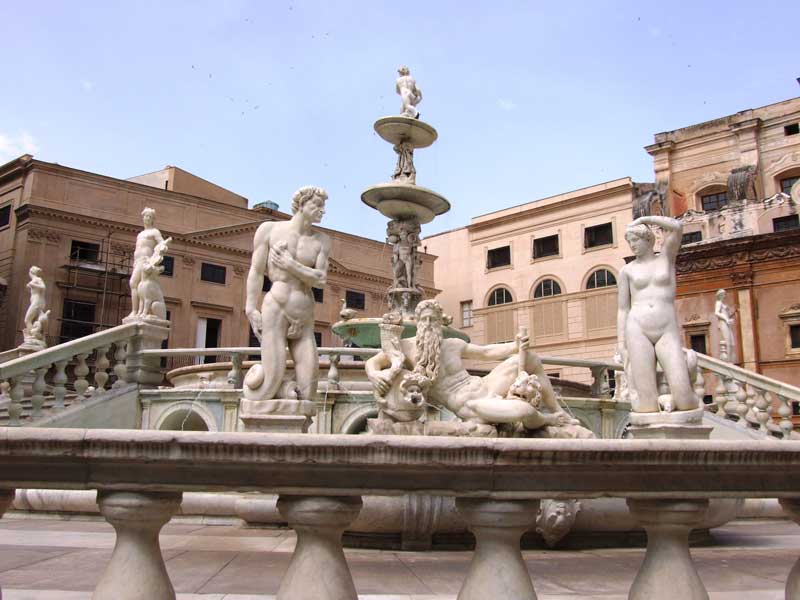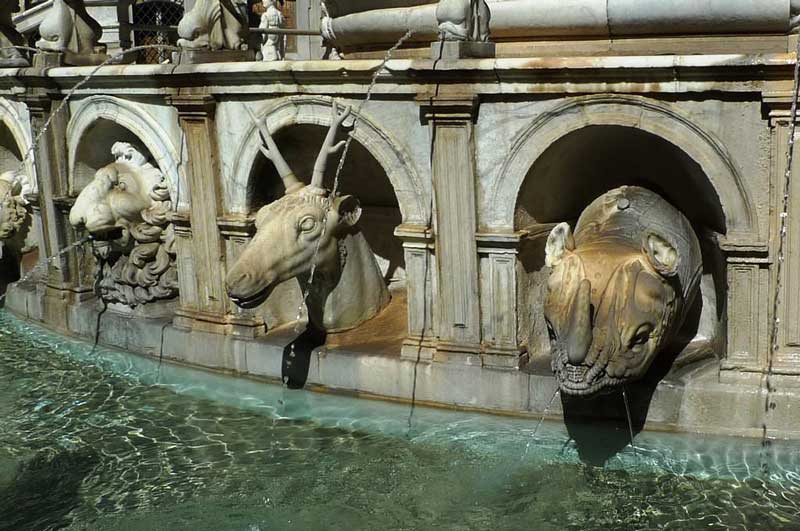
Designed and crafted by the Florentine sculptor Francesco Camilliani, Fontana Pretoria was commissioned by a Spanish nobleman Don Luigi Toledo, brother of the Duchess Eleonora of Toledo, as he decided to embellish the garden of his villa in Florence with an imposing fountain. However, as Don Pedro died before the completion of the fountain, it was sold to the city of Palermo and was transferred in the city in 1574.
Initially, the Senate of Palermo decided to install it in the square in front of the Palazzo Pretorio. Later, in order to make room for the fountain, several buildings were demolished and it was proudly positioned in front of the Palazzo Pretorio, the Municipal Hall, in a bid to outshine the newly crafted Fontana di Orione in Messina. However, as the tired basins of the fountain encircled and crowded with nude nymphs, sirens, tritons and river gods, the inhabitants of Palermo dubbed it as Fontana della Vergogna or Fountain of shame and even today it is known to the locals by the same name.


In order to transport the fountain from Florence, it was uprooted from a garden and disassembled in 644 pieces, which arrived in Palermo on 26 May 1574. However, on arrival, it was found that some of the sculptures attached to the fountain were damaged during the transport, while many others were missing, which were probably kept by Luigi de Toledo.
Probably, the statues of the ‘Two Divinities’ were preserved in the Bargello Museum of Florence and others were placed somewhere in Naples and then moved in the garden of Abadia, in the Spanish city of Caceres.



Under the circumstances, it became necessary to make some new adjustments in Palermo. The responsibility of assembling the structure was entrusted to Camillo Camilliani, son of the Florentine sculptor Francesco Camilliani, who completed the job in 1581, with the help of Michelangelo Naccherino. Apart from many mythological figures, animals, monsters, sirens, tritons and the rivers of Palermo, the fountain is decorated with twelve Olympians, the major deities of the Greek pantheon, who according to tradition, resided on Mount Olympus. One among the statuettes guarding the ramps is Ceres, the classical patroness of Sicily. In addition to the nude violin players, the concentric circles of the fountain are richly ornamented with lots of animals spouting water, while the fountain creates ripples in the basin below with unrestrained jubilation.

However, between the 18th and the 19th century, the fountain was considered by a major section of the inhabitants of the city as a sort of depiction of the corrupt municipality of Palermo, due to the shamelessly stark nudity of the statues in an open public place. Apart from naming the magnificent fountain as the Fountain of Shame, the square also became notoriously known as Piazza della Vergogna or the Square of Shame.
Nevertheless, the Fountain of shame has a tremendous magnetic attraction of its own, which compels a passerby to turn around to it several times, only to discover new details, a new impression and the grace of each statue that create an immense urge to reach out and touch them. The Fountain of Shame is floodlit at night, which makes it more absorbing and shamelessly romantic, while creating a dreamy atmosphere in the whole surroundings.